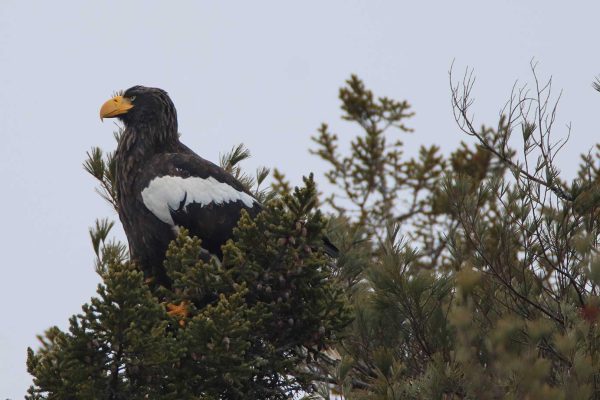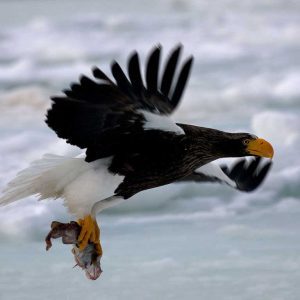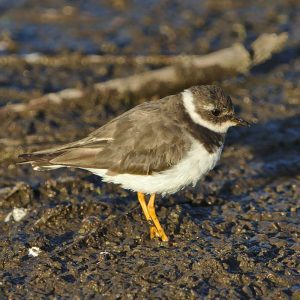The superstar Steller’s Sea-eagle is back!
Last winter, Maine hosted the mega-popular rarity that delighted birders with stops along the midcoast, sending birders and the simply curious alike flocking to places like Georgetown, Boothbay Harbor, and Pemaquid. Unless you live under a rock, you probably remember the flurry of excitement. After all, this is one of the world’s largest birds, and it’s super cool—so cool that we wrote about it not once but twice. Like most celebrities, the sea-eagle managed to make its way not only all over the internet but also onto news programs, TikTok, and everything in between.

The celebrity Steller's Sea-eagle that graced Maine—and attracted a gazillion bird enthusiasts—returned to Maine as of early February! (Photo courtesy of Zachary Holderby)
In keeping with the birds massive size—it’s got a six- to eight-foot wing span!—the bird’s massive bright yellow bill make it distinctive, along with its white wing patches and white tail. The fact that the Steller’s Sea-eagle’s natural range is in Russian Siberia (south in winter to South Korea and northern Japan), and that they have a small global population size, also makes them a very special bird. After bopping about on several coastal peninsulas, the bird was last seen in late March of 2022.
Next stop, Nova Scotia, where the bird was spotted in early April. From there it moved on to southern Newfoundland in late April. It scooted around different areas in Newfoundland, seen occasionally and briefly, but in July and August it became a sensation among birders in southeastern Newfoundland when it stayed put for a month or so. The bird was next spotted in October on Saint Pierre and Miquelon, small islands off southern Newfoundland that are overseas territories of France. In late November, the sea-eagle was found along the coast of New Brunswick.
Then it disappeared again.
Now it’s back in Maine, seen along the Back River between Arrowsic and Georgetown, where it had delighted birders last winter. It immediately began drumming up excitement, drawing crowds of birders from across Maine, New England, and beyond, with some birders who missed it last year determined not to do so again. Some booked flights to Maine, just for the occasion!
What’s nice about this particular rare bird is that it is well within viewing distance but far enough to not cause concern about it being (unintentionally) harassed by so many excited birders. Reports from the Route 127 bridge say the traffic sometimes dribbles through in a single lane, which is probably not a joy to the locals, and we trust everyone is being careful and respectful of private property as well.

A Steller’s Sea-eagle in Hokkaido, Japan, which is part of the species’ native range. (Credit: Jambomambo13, creativecommons.wikimedia)
As before, the locations and habits of this Steller’s Sea-eagle are again being well documented. For fun, we took a look at eBird to see where else Steller’s Sea-eagles are being seen at the moment. Most are in northern Japan (Hokkaido), with a few farther south in Japan and a scattering across South Korea—including several sightings just miles from the border with North Korea. Who would have thought that a wayward sea-eagle could provide such a great lesson in world geography!

Common Ringed Plovers are very hard to tell apart from the Semipalmated Plover, requiring careful study including noting whether or not they have webbing between the inner toes (no webbing=ringed plover). This photo is of a wintering Common Ringed Plover in Africa. (Photo by Derek Keats courtesy Wikemedia Commons)
Another rare bird that has been found in Maine has less celebratory outcome. A Common Ringed Plover, a Eurasian twin to the familiar Semipalmated Plover that we see here in Maine during spring and fall migration, was discovered in late January in southern Maine at Timber Point, Rachel Carson National Wildlife Refuge, between Biddeford Pool and Goose Rocks Beach. What was probably the same bird had been found in Nova Scotia in early January. This is Maine’s third record of this species, although the two previous records were in the August-September time period, at the height of shorebird migration. The middle of winter is certainly not when we would expect a bird like this to appear.
As you might have guessed, a rare bird of this caliber attracted many birders who were able to see it. Unfortunately, though, unlike the sea-eagle that is built for a Maine winter, even if it’s not really supposed to be here, ringed plovers are not well-suited to deal with the Arctic freeze Maine experienced over the weekend. Sadly, it was found dead on the beach within days of those ultra-cold temperatures.
These two species are great reminders that while rare birds that show up unexpectedly are a delight for birders to see and marvel at, the reasons for their visits are often complex, and not always in their own best interest. Documenting their movements and population changes will be increasingly important in a rapidly changing world. Thankfully, there is no shortage of rare bird enthusiasts to help make that happen.
—Jeff and Allison Wells











Leave a Reply